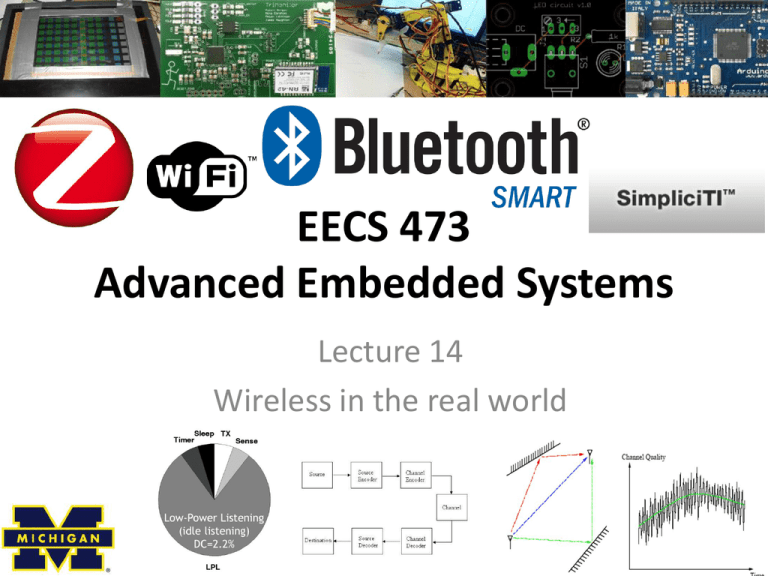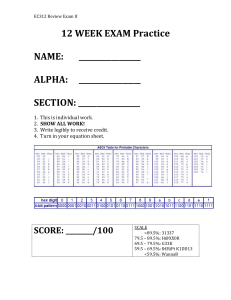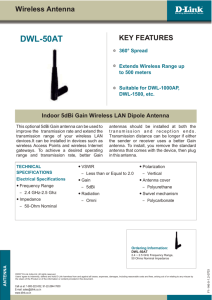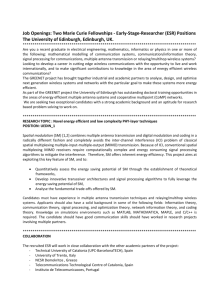pptx
advertisement

EECS 473 Advanced Embedded Systems Lecture 14 Wireless in the real world Team status updates • • • • • Team Alert (Home Alert) Team Fitness (Fitness watch) Team Glasses Team Mouse (Control in hand) Team WiFi (WiFi localization) Guest talks • One this Thursday 11/12 – Senior engineer who builds all kinds of things including power supplies • One on 11/24 – National Instruments, board-level issues • One TBA, but more on software side. • Recall part of homework score is attendance at guest talks. – If you have a conflict, let me know and I’ll find makeup something you can do Last time • Covered: –Messages • Source encoding (compression) • Channel encoding (error correction) • Modulation –Medium • A bit on the FCC Today • Review last time • Wireless range – Antennas – Broadcast and receive power • FCC (again) • Bandwidth and Shannon’s limit • A quick overview of 802.14.5 packets and bandwidth Review: Communication theory • What are each of these boxes? Source Encoder Channel Encoder Modulator Channel Source Decoder Channel Decoder Demodulator Review: Channel encoding/decoding • What is a block code? – What is a Hamming(7,4) code? • How does this figure relate? • What is a convolutional code? – What makes it different than a block code? • Channel encoding (error correction) involves sending a lot of extra bits along with the “useful data” (maybe 2x or 3x total!). – Why is this helpful when trying to send a lot of data quickly? Review: Modulation Review: Modulation • Draw the message “0110” using the following constellations: So, who cares? Noise immunity • Looking at signalto-noise ratio needed to maintain a low bit error rate. – Notice BPSK and QPSK are least noise-sensitive. – And as “M” goes up, we get more noise sensitive. • Easier to confuse symbols! On to… Antennas and transmission power • Antennas receive power differently depending on where the power is coming from. – An isotropic antenna is one that receives power equally well from all directions. • These don’t exist. • Real antennas focus their “effort” more in some directions than others. – A narrow antenna, like a dish, will be focused in a very narrow range (radiation angle) – Others, like a traditional dipole (the most common antenna) tend to have less narrow of a range. Antennas • Nothing is free here. – If you have a narrow beam, you get some great gain in that beam but get loss in the other directions. Toroidal radiation pattern • This can be good. • Think about body-area networks or Bluetooth headphones Figures from antenna-theory.com (if you couldn’t tell…) Dish antenna radiation pattern Radio power • Radio signals are generally measured in Watts – However embedded systems generally measure power in mW • Typically 30-100mW for WiFi – It is often easiest to deal with power on a log scale. • So we use “dBm” where Basically just dB but scaled to mW. Much of this (including graphics) from http://www.adm21.fr/images/files/Industrial_Wireless_Guidebook.pdf Aside: dB, dBm, dBi • dB itself is a unit-less value – Generally a ratio between two thing – On a log scale. • dBm a single value where the “ratio” is to 1mW. – So 20dB means a 100 to 1 ratio – 20dBm means 100mW (100 times 1mW) • We’ll also see dBi when looking at antennas. – That’s the power ratio of an antenna to an isotropic antenna (that completely non-directional antenna) – You might see dBd, which is compared to a lossless dipole antenna. It’s 2.15dB lower than dBi. • Vendors generally use dBi (‘cause it’s bigger) and thus so will we. Power received vs. power sent. • The Friis Transmission Formula tells us how much power we’ll receive. It is: • However, many of those terms aren’t easily available from real spec. sheets. • Instead we do some algebra and get the following equation for range in km: Where: – Pt is the radiated power – Pr is the received power – Gt is the gain of the transmitting antenna – Gr is the gain of the receiving antenna – λ is the wavelength – R is the distance between antennas • Where f is the frequency in MHz, pt and pr are in dBm and gt and gr are in dBi. Example • You are running an IEEE 802.11b network and you are currently using wireless devices with the following specifications: – Tx power: 18 dBm @ 11 Mbps – Rx sensitivity: -81dBm @ 11 Mbps – Antenna gain: 2 dBi (both) – 802.11b is at 2.4GHz. • Notes: – We are looking at 63mW of broadcast power. – If we had dish antennas pointed at each other with a gain of 25dBi, we’d have (18+50+81)/20=275km! – Note that this assumes an unobstructed line-of-sight signal with no significant interference. • Sometimes realistic, often not. Looking at a real antenna (ANT-WSB-ANF-09) • 9dBi – Gets there by radiating in a toroid • Spread evenly along the ground (half power bandwidth is 360) • Doesn’t go up or down at all. – Half power BW is at 10 Image taken from: en.wikipedia.org/wiki/File:United_States_Frequency_Allocations_Chart_2003_-_The_Radio_Spectrum.jpg United States Partial Frequency Spectrum Image taken from: en.wikipedia.org/wiki/File:United_States_Frequency_Allocations_Chart_2003_-_The_Radio_Spectrum.jpg OK, so all 2.4 GHz things have on 50MHz of bandwidth • What does that mean? – It limits how much data we can send. • To really understand that in a meaningful way, let’s look at the theoretic limitations. – Shannon’s limit. Shannon’s limit • First question about the medium: – How fast can we hope to send data? • Answered by Claude Shannon (given some reasonable assumptions) – Assuming we have only Gaussian noise, provides a bound on the rate of information that can be reliably moved over a channel. • That includes error correction and whatever other games you care to play. Taken from a slide by Dr. Stark Shannon–Hartley theorem • We’ll use a different version of this called the Shannon-Hartley theorem. • C is the channel capacity in bits per second; • B is the bandwidth of the channel in hertz • S is the total received signal power measured in Watts or Volts2 • N is the total noise, measured in Watts or Volts2 Adapted from Wikipedia. Comments (1/2) • This is a limit. It says that you can, in theory, communicate that much data with an arbitrarily tight bound on error. – Not that you won’t get errors at that data rate. Rather that it’s possible you can find an error correction scheme that can fix things up. • Such schemes may require really really long block sizes and so may be computationally intractable. • There are a number of proofs. – IEEE reprinted the original paper in 1998 • http://www.stanford.edu/class/ee104/shannonpaper.pdf – More than we are going to do. • Let’s just be sure we can A) understand it and B) use it. Comments (2/2) • What are the assumptions made in the proof? – All noise is Gaussian in distribution. • This not only makes the math easier, it means that because the addition of Gaussians is a Gaussian, all noise sources can be modeled as a single source. • Also note, this includes our inability to distinguish different voltages. – Effectively quantization noise and also treated as a Gaussian (though it ain’t) • Can people actually do this? – They can get really close. • Turbo codes, • Low density parity check codes. Examples (1/2) • C is the channel capacity in bits per second; • B is the bandwidth of the channel in Hertz • S is the total received signal power measured in Watts or Volts2 • N is the total noise, measured in Watts or Volts2 Adapted from Wikipedia. • If the SNR is 20 dB, and the bandwidth available is 4 kHz what is the channel capacity? – Part 1: convert dB to a ratio (it’s power so it’s base 10) – Part 2: Plug and chug. Examples (2/2) • C is the channel capacity in bits per second; • B is the bandwidth of the channel in Hertz • S is the total received signal power measured in Watts or Volts2 • N is the total noise, measured in Watts or Volts2 Adapted from Wikipedia. • If you wish to transmit at 50,000 bits/s, and a bandwidth of 1 MHz is available, what S/R ration can you accept? Summary of Shannon’s limit • Provides an upper-bound on information over a channel – Makes assumptions about the nature of the noise. • To approach this bound, need to use channel encoding and modulation. – Some schemes (Turbo codes, Low density parity check codes) can get very close. 802.15.4 • IEEE 802.15.4 is a standard which specifies the physical layer and media access control for low-rate wireless personal area networks (LR-WPANs). – Many embedded wireless protocols are built on top of this (including Zigbee) • • The Synchronization header (SHR) contains a preamble sequence (32 bits, or 4 octets) to allow the receiver to acquire and synchronize to the incoming signal and a start of frame delimiter that signals the end of the preamble. The PHY header (PHR) carries the frame length byte, which indicates the length of the PHY Service Data Unit (PSDU). – The SHR, PHR and PSDU make up the PHY Protocol Data Unit (PPDU). • • • The PSDU contains the MAC Header (MHR), which has two frame control octets, a single octet Data Sequence Number, good for reassembling packets received out of sequence, and 4 to 20 octets of address data. The MAC Service Data Unit (MSDU) carries the frame’s payload and has a maximum capacity of 104 octets of data. Finally, the MPDU ends with the MAC Footer (MFR), which contains a 16-bit Frame Check Sequence. From: An Introduction to IEEE STD 802.15.4 by Jon T. Adams Putting it all together Acknowledgments and sources • A 9 hour talk by David Tse has been extremely useful and is a basis for me actually understanding anything (though I’m by no means through it all) • A talk given by Mike Denko, Alex Motalleb, and Tony Qian two years ago for this class proved useful and I took a number of slides from their talk. • An hour long talk with Prabal Dutta formed the basis for the coverage of this talk. • Some other sources: – http://www.cs.cmu.edu/~prs/wirelessS12/Midterm12-solutions.pdf -- A nice set of questions that get at some useful calculations. – http://people.seas.harvard.edu/~jones/es151/prop_models/propagation .html all the path loss/propagation models in one place – http://people.seas.harvard.edu/~jones/cscie129/papers/modulation_1.p df very nice modulation overview. – http://www.adm21.fr/images/files/Industrial_Wireless_Guidebook.pdf A very nice overview of everything wireless for the applied engineer. Wish I’d found it sooner! • I’m grateful for the above sources. All mistakes are my own. Additional sources/references General • http://www.cs.cmu.edu/~prs/wirelessS12/Midterm12-solutions.pdf Modulation • https://fetweb.ju.edu.jo/staff/ee/mhawa/421/Digital%20Modulation.pdf • http://www.ece.umd.edu/class/enee623.S2006/ch2-5_feb06.pdf • https://www.nhk.or.jp/strl/publica/bt/en/le0014.pdf • http://engineering.mq.edu.au/~cl/files_pdf/elec321/lect_mask.pdf (ASK) • http://www.eecs.yorku.ca/course_archive/201011/F/3213/CSE3213_07_ShiftKeying_F2010.pdf Other: • An Introduction to IEEE STD 802.15.4 by Jon T. Adams
![EEE 443 Antennas for Wireless Communications (3) [S]](http://s3.studylib.net/store/data/008888255_1-6e942a081653d05c33fa53deefb4441a-300x300.png)




